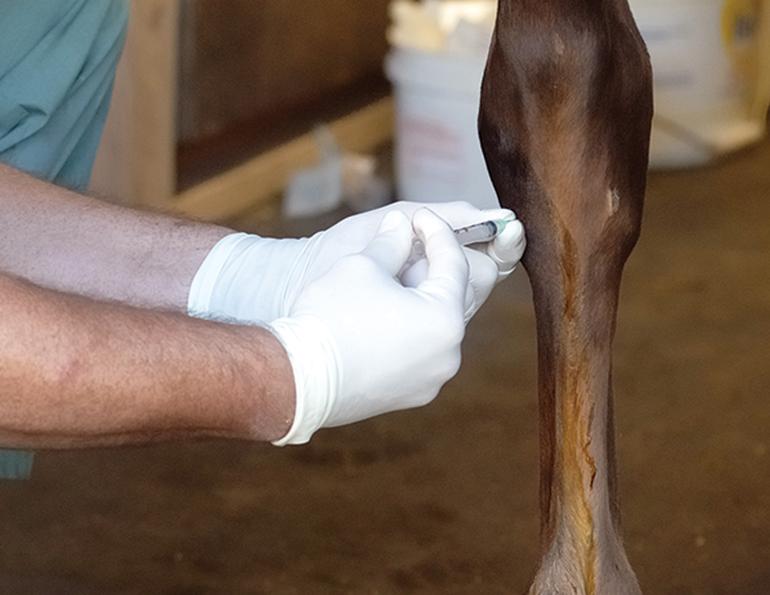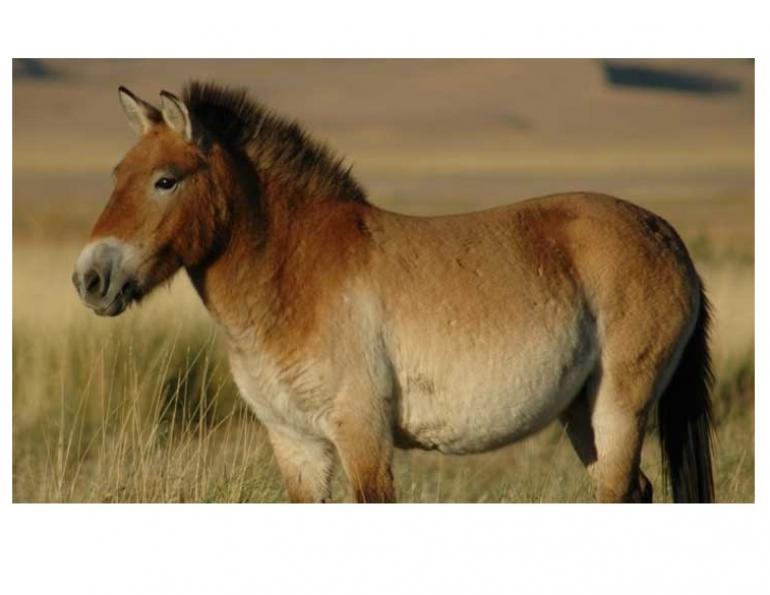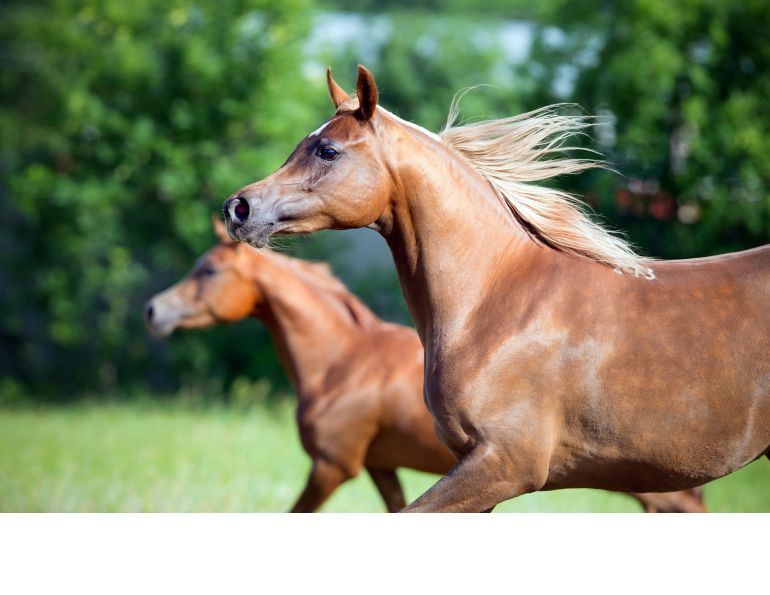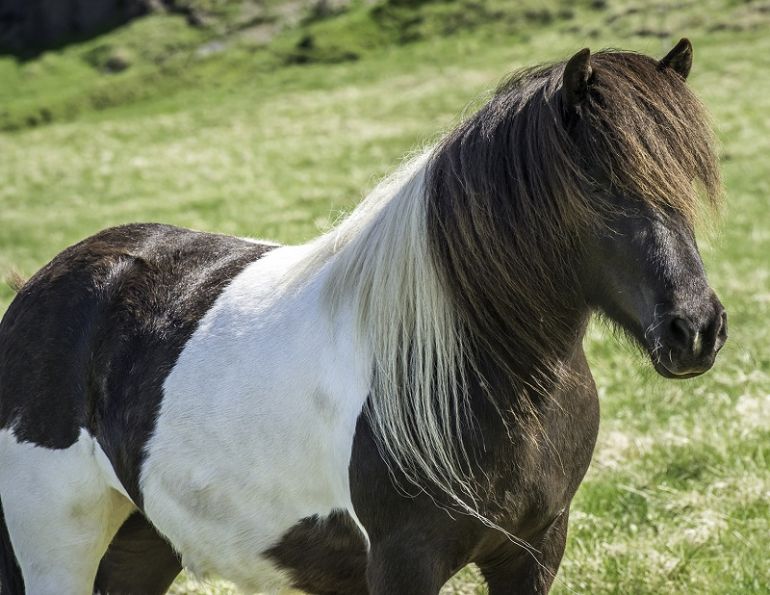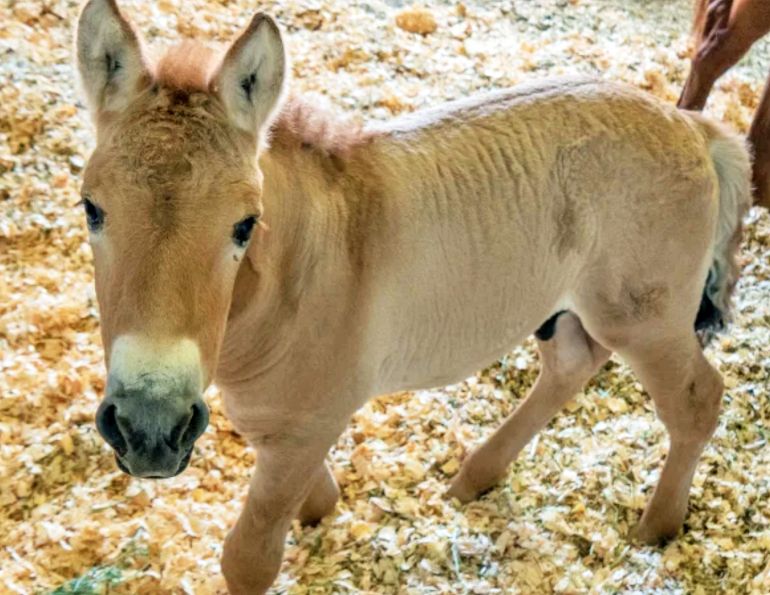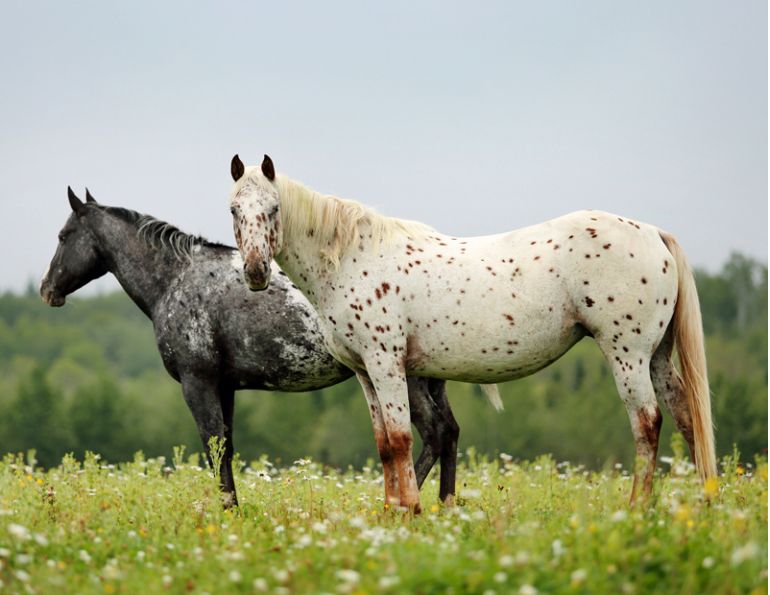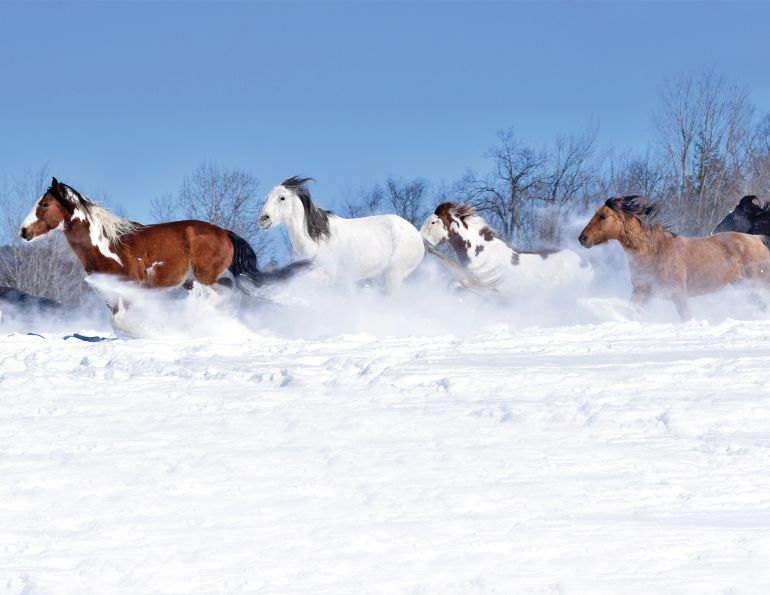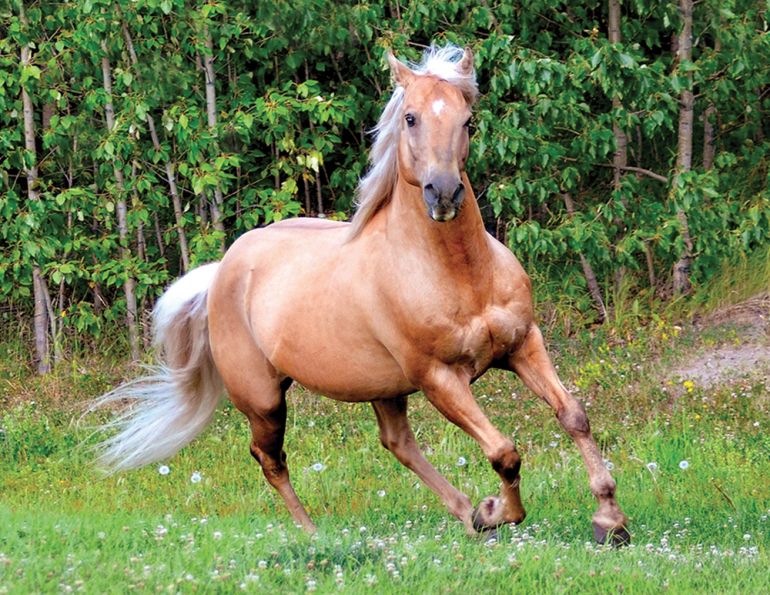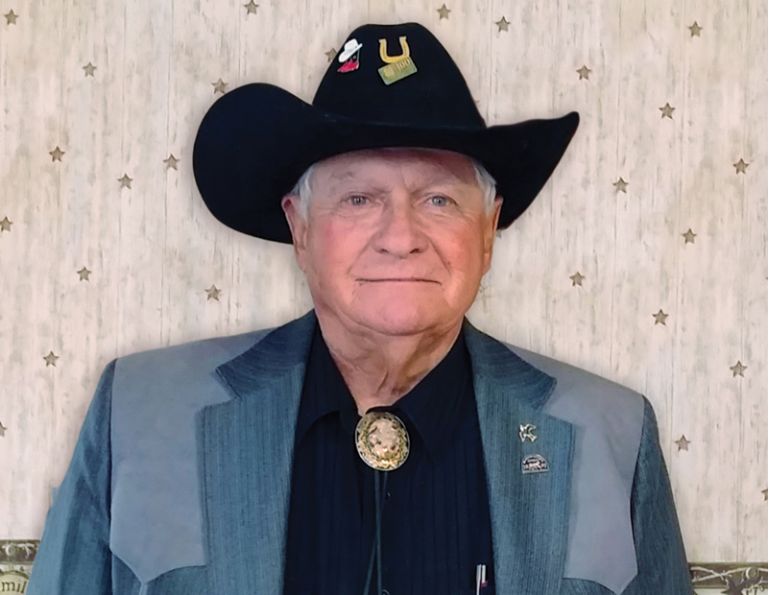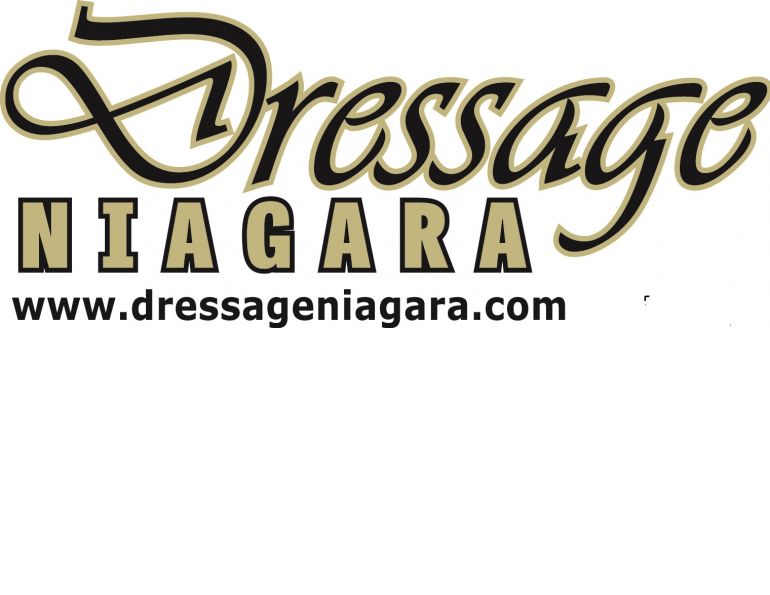The Gentle Giant
By Margaret Evans
Delvin Szumutku was stressed. It was 1983 and he was living on the family farm in Saskatchewan where they grew grain and had been breeding Clydesdale horses since the 1960s. But his father was sick and in urgent need of heart surgery. He had been ordered by his doctors not to lift even so much as a suitcase, a tough call for a farmer. But despite his condition, he badly wanted to show six of their Clydesdales at the Yorkton Harvest Show that was just a day away.
From Delvin’s perspective, that wasn’t happening. But he agreed with his dad that he would take one horse, their stallion Boulder Bluffs Maxwell. Far from being ready, Maxwell hadn’t even been groomed and his mane, tail, and feathers were all dirty and knotted. With no prep time, Delvin loaded Maxwell and drove all evening to the show grounds, pulling in at midnight. He had ten hours to get his horse show-ready.
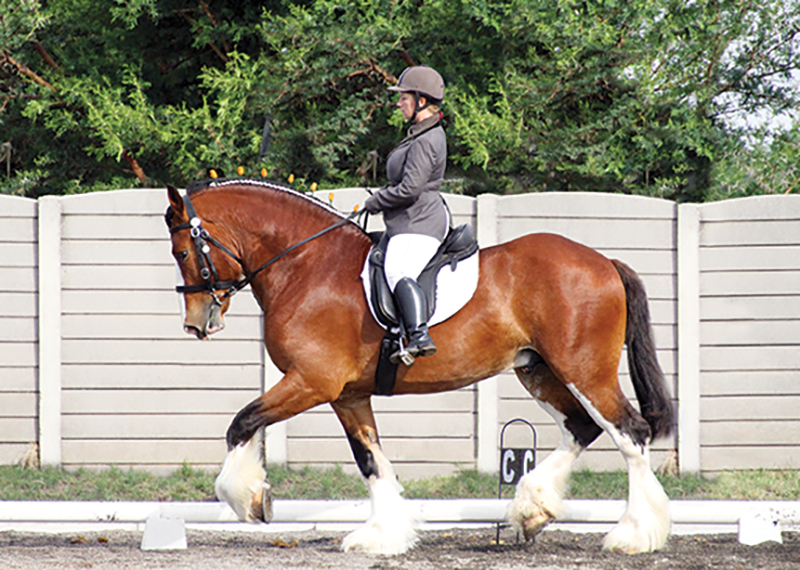
Versatility is one of the Clydesdale’s most valuable strengths, and many individuals can go from harness to saddle, and from farm work to show ring with ease. Photo: Angelique Cruickshank
“I was walking him through the grounds to a stall and there were two old Clyde guys staring at Maxwell,” recalls Delvin. “One muttered, ‘Why would they bring something like that here?’”
Undaunted and determined to make his father proud, Delvin scrubbed his horse all night, washed, trimmed, and thinned the mane and tail, and washed the feathers until they were pure white. At 10 am, as ready as possible, he was in the show ring. He was ecstatic when Maxwell won the supreme champion award. Leading him out, the two old Clyde guys stared at him, speechless.
Delvin looked straight at them with an irrepressible, cheeky grin. “That’s why I brought him here!”

Boulder Bluffs Maxwell winning supreme champion at Yorkton Harvest Show in 1983, being exhibited by a younger version of Delvin Szumutku. Photo courtesy of Delvin Szumutku
Clydesdales are among some of the best-loved and most recognized of draft horses. And, like all great stories, theirs began long ago and far away.
If Lanarkshire, Scotland, has one claim to fame, it’s their impressive history for land management that goes back to the fifth century when monks in local monasteries were up to speed with fruit growing. In the Middle Ages, 11th century monks living in the priories that held land in the River Clyde Valley imported some continental know-how in managing natural resources, harvesting trees, and cultivating orchards.
Over the centuries, trees for firewood, building, industry, and transportation were at the heart of everything. Along the River Clyde, woodlands of birch, ash, oak, elm, and alder were managed by a system of “coppice with standards,” a method of creating a crop of mature trees harvested long term on a rotational basis. Plantations of pine and larch added to the mosaic of trees that provided a continuous source of annual income.
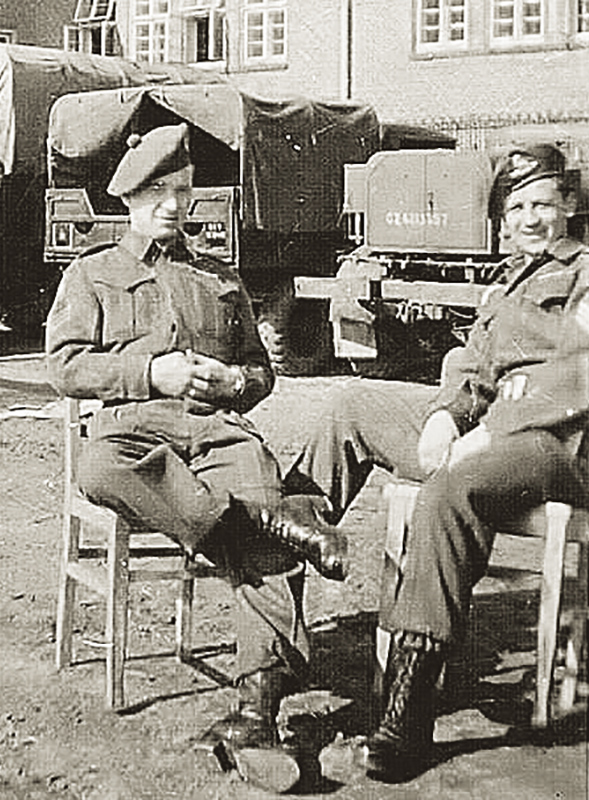
Delvin Szumutku’s father, Joseph Marvin Szumutku (right), was born in 1923 in Stockholm, Saskatchewan, the fifth of nine children. His father died when he was 11 and farm work became his responsibility. He joined the Canadian Armed Forces when World War II broke out and as a sergeant saw active combat in France, Italy, Sicily, and Germany. He was seriously wounded in Belgium when a mortar shell exploded, killing his best friend. Upon recovery, he was sent back into action until the war ended, and served as a guard at the Nuremburg War Trials. He returned home, bought a homestead of 640 acres, and began farming grain with the use of Clydesdale horses. “It’s because of him and his teaching that Louise and I have been able to keep the tradition of Clydesdale Creek Farms alive and thriving,” says Delvin Szumutku. “He was the best horseman I will ever know and he will always be my best friend. I had the best teacher there was.” Photo courtesy of Delvin Szumutku
By the end of the 1700s, over 300 acres of Lanarkshire were devoted to horticulture, 75 percent of which was on the banks above the Clyde. As farming expanded, so did industry. Trees were harvested for supports for the coal mines, and hardwood was needed to make the colliers’ creels and tool handles as well as the wooden rails used by the pit ponies hauling coal. Local wood supplied the textile factories, as bobbins and shuttles were made from birch. Wood was in high demand for products and to make the carts needed to haul goods to market, all of which were pulled by horses.
Enter Lanarkshire’s second claim to fame – a beautiful, strong, and superior draft horse, bred in the Clyde valley and up to the task. Those horses working in Clydesdale, the historic name for Lanarkshire, would become the famed Clydesdale horse, a breed that has been in existence since 1727.
Around 1750, breeding Clydesdales took a fundamental shift when James Hamilton, the 6th Duke of Hamilton, upgraded the breed by importing stallions with greater muscle and substance. He chose the Flemish (or Flanders) draft horse of Belgium, one of the most admired European heavy horse breeds and known since the Middle Ages as influential in the early breeding of large, strong working horses.
Related: The Gorgeous Gypsy Vanner Horse

Clydesdale Creeks Conroy, a Szumutku foal currently in training to be part of the Budweiser eight-horse hitch. Photo courtesy of Delvin Szumutku
Hamilton imported the first Flemish stallion to the Clydesdale region. It was dark brown and was kept for the benefit of his tenants who were given access to the stallion to breed their mares, free of charge.
Soon after, John Paterson of Lochlyloch imported a Flemish stallion from England. It was black with a white face and some white on the legs. The Lochlyloch bloodline was quickly sought after and the stallion was bred to local mares. The breed was so admired for its work ability that the Clydesdale Horse Society was initiated right before the Glasgow Stallion Show on the last Tuesday in February 1877. The Society launched in June 1877, its aim to maintain the purity of the breed and promote the horse’s qualities. The first volume of the Clydesdale Horse Stud Book was published in December.
With the stud book, pedigrees could be traced over generations. In 1808, Mr. Somerville of Lampits Farm purchased a filly at a dispersal sale. The Lampits mare went on to produce Thompson’s Black Horse, or Glancer. According to the association’s historical notes, he had white on both hind legs and was described as having “A strong neat body set on short thick legs, the clean sharp bones of which were fringed with nice, flowing silken hair.”
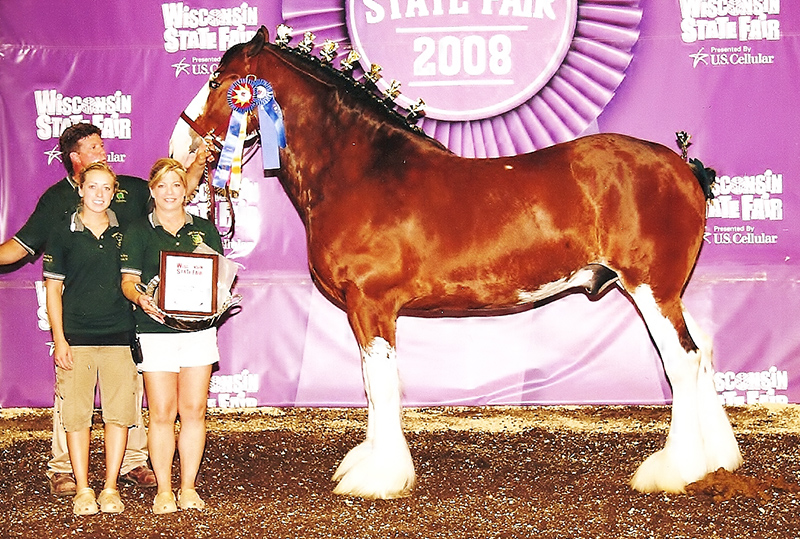
Clydesdale Creeks Jacob, winning top honours at the National Clydesdale Show in Wisconsin, USA, in 2008. Photo courtesy of Delvin Szumutku
Along came Farmers Fancy and Glancer I. Others followed including Keir Peggy, Darnley, MacGregor, Top Gallant, Sir Everard and Baron’s Pride. One of the breed’s most famous stallions was Baron of Buchlyvie.
The Clydesdale quickly built a reputation as a horse not only of power and ability, but also of style, beauty, intelligence, a willingness to work, and with a personality that made them such a pleasure to work with. Today, most Clydesdales are bay, brown, or black, with white legs and a blaze. They have straight, silky feathering covering their lower legs and hooves. They stand an average 17 to 18 hands, weighing some 800 to 900 kilograms and are well muscled with an elegant, energetic gait, arched neck, and proud presence.
“The thing that I most admired was the quality of their flat bone and that beautiful hind leg,” says Delvin Szumutku who now owns Clydesdale Creek Szumutku Farms in Stockholm, Saskatchewan. “The Clyde horse has been blessed with the finest set of legs in the draft horse world. That along with the abundant silky hair that we call feathers makes them unique among the draft horse breeds. Put that together with beautiful colours and their wonderful disposition, and you have the closest thing to perfection in the horse world.”
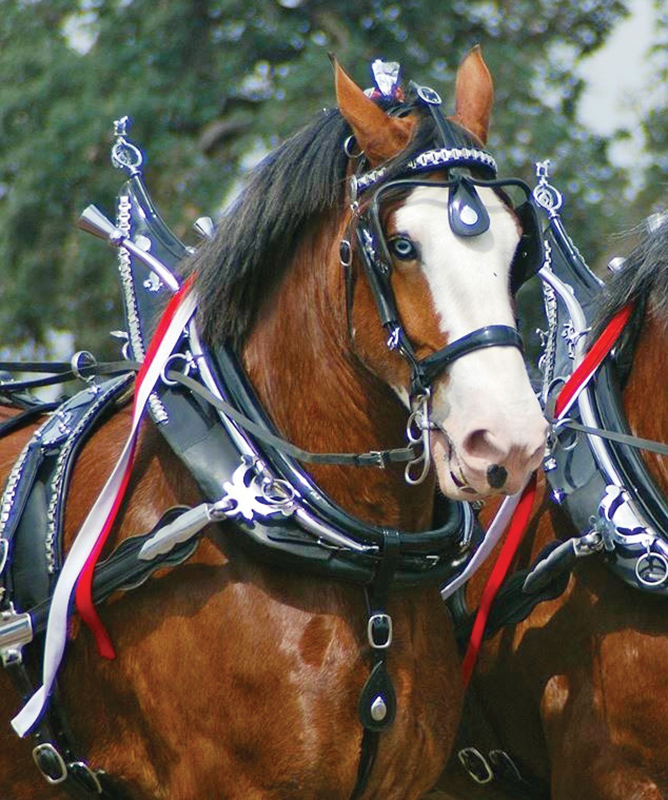
Clydesdale Creeks Princeton, right lead horse for the Rock Crusher hitch in California. Photo courtesy of Delvin Szumutku
Their reputation spread across Great Britain and internationally. Clydesdales were exported to Australia, New Zealand, South Africa, and the United States.
The first Clydesdale imported to Canada was a stallion called Cumberland, arriving in Ontario in 1840. The horse set the stage for Clydesdales to become the first draft breed to be found in most of the provinces. Clydesdales were in Manitoba by 1881. They came to the Alberta foothills in 1883, and a stallion purchased by the Douglas Lake Cattle Company arrived in British Columbia in 1887, just one year after the Clydesdale Horse Association of Canada was formed in 1886. The breed went on to receive top honours at shows and was sought after at sales across the continent.
“I started with my own Clydesdales in the early 1980s,” says Calvin Martin who owns Boulder Bluff Clydesdales in Strathclair, Manitoba. “My father had been in the business for a long time before that. We all have the challenge of trying to improve the breed and breed each generation to be better than the one before. Also, keeping the horses healthy and raising the newborn foals each year is a challenge. The successes would be raising ones that you are proud to own and for other breeders to think the same and want to buy from you. We have had some success in the show ring and have had the pleasure of having horses we have sold do well for their new owners.”
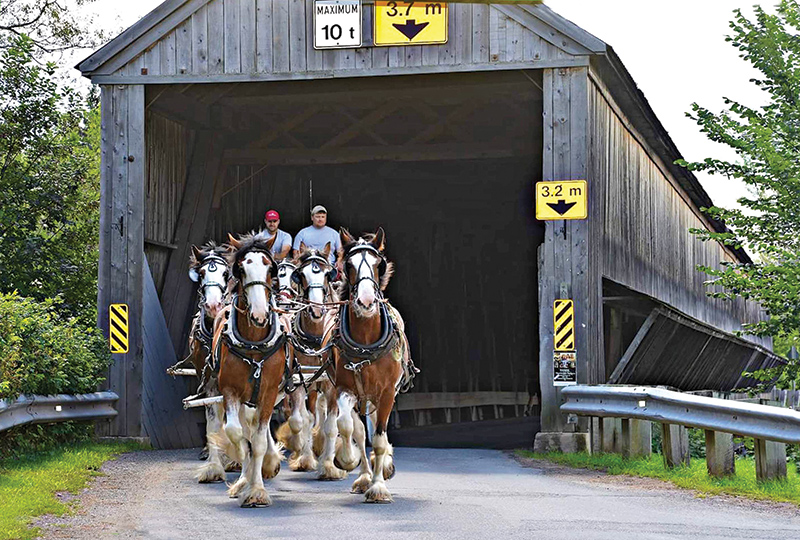
The Covered Bridge Clydesdales six-horse hitch coming through the Patrick Owen Bridge, the covered bridge for which the farm was named. All but one horse in this hitch was home-born and raised. David and Wesley Hayward are on the wagon. Photo courtesy of David Hayward.
Like so many breeders, Martin loves the style and easy disposition of the Clydesdale.
“They are a very versatile animal,” he says. “People use them as chore teams and work horses. More and more they are being used as riding horses. People ride them for pleasure, in different types of competition, and trail riding. [They] like their quiet nature and attitude. They’re a popular hitch horse in the show ring because of their action, style, and crowd appeal. They are very people-friendly and for that reason a lot of people like to have them around as just pets.”
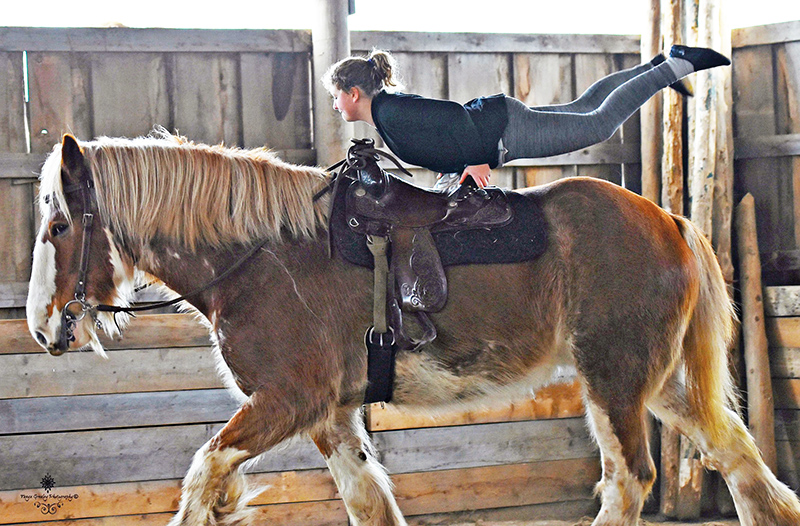
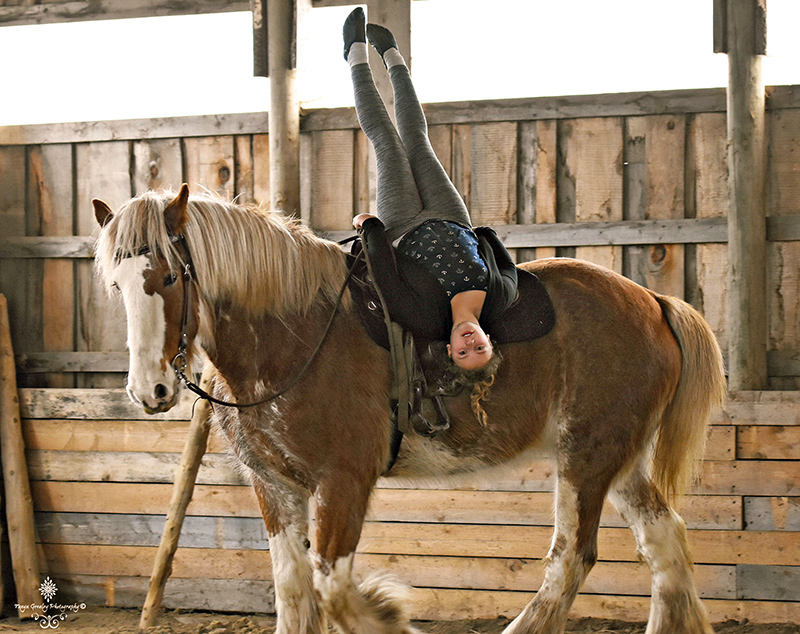
Virginia Hayward of Covered Bridge Clydesdales trick riding on the mare, Westerdale Golden Girl. Photo courtesy of David Hayward.
That friendship trait is loved by everyone.
“The Clyde loves to please,” says Sherry Lewis, owner with husband Steve of Terragold Farm in Cannington, Ontario. “They enjoy being made a fuss of and talked to. Under saddle I find that they are not as spooky or jumpy as some other breeds, and love the trail or pleasure aspect of being ridden. To prove some of the characteristics of these horses, a friend was at our place and we were trying out a five-year-old gelding under saddle. This was the first time we had saddled him and I rode him around the driving ring. He was, as I expected, super.”


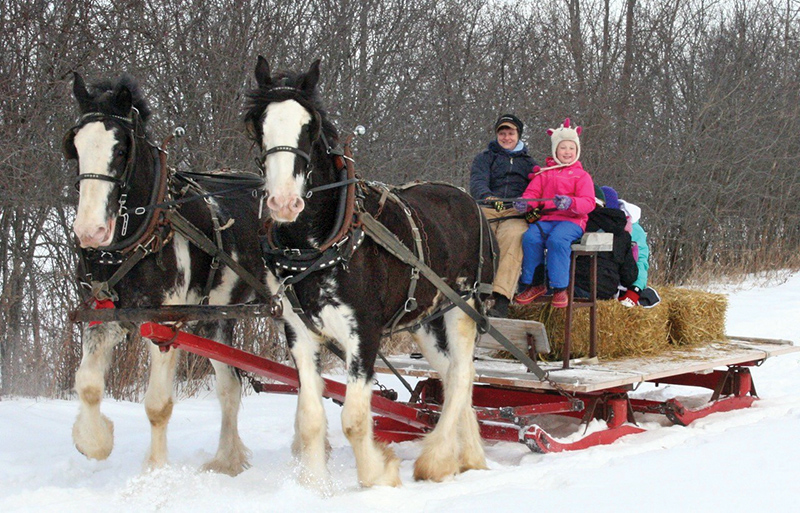
Terragold Farm Clydesdales hard at work. Photo courtesy of Sherry Lewis.
Her friend rode the gelding but when she dismounted, the saddle slipped and she fell, landing on the ground under horse’s belly. At first, they were horrified for fear the big draft horse would step on her but he merely swung his head around and looked at her, puzzled. They laughed with relief as she nimbly crawled out of harm’s way.
“Imagine if that was a spooky horse,” she says. “That is another thing that I find. Most of these horses will go out of their way to avoid hurting you accidentally. As a kid I remember working in the woods skidding logs with my dad. My younger brother was with us and he had a log that was tricky so, instead of being behind the horse and driving him, he was at his head trying to wiggle this log out. Well, didn’t he slip and fall right under the horse’s front feet! That horse almost did a summersault to avoid my brother. He went down on his knees to miss him and never did touch him. He just skimmed over his body and stopped on the other side! Dad and I were too scared to move!”
It’s that sense of awareness and poise that Lewis really admires and it comes from a personality that’s admired across the country.

Two young friends in their winter woollies at Terragold Farm in Cannington, Ontario. Photo courtesy of Sherry Lewis.
“Clydes have an excellent personality,” says Tim Awckland who owns River Run Farm Clydesdales in Arras, British Columbia. “They tend to be easy to train to ride and drive, and quickly become your best friend. It only takes a few weeks in the barn for the youngsters to become puppy dogs. They are excellent carriage horses in cities where they need to stay calm with traffic.”
Awckland bred Belgians before starting his breeding program with Clydesdales in the early 2000s.
“There is a difference in their personalities. The Clydesdales are much more docile and easy to train. We were also attracted to the conformation quality of the Clydes and their flowing movement. There isn’t a prettier sight than a halter horse brought into the show ring.”
That presence will catch the attention of the judge.

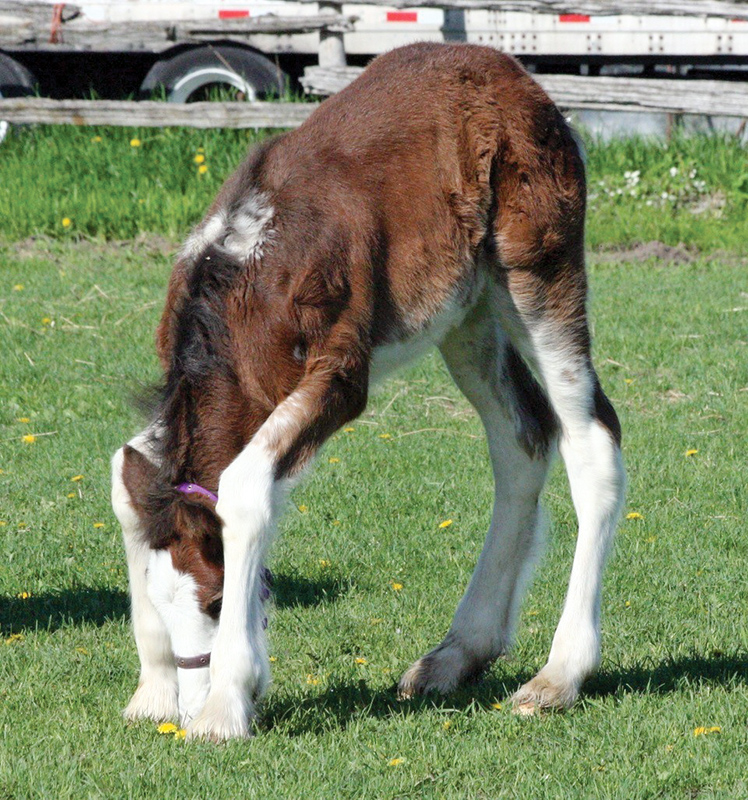
An adorable foal and one of the gentle giants at Terragold Farm. Photos courtesy of Sherry Lewis.
“First impression as a judge means a lot,” says Steve Gregg, draft horse judge and award-winning Clydesdale breeder at Gregglea Clydesdales, his family farm near Cargill, Ontario.
He explains that the key is a well-balanced animal that can move extremely well on both ends for halter or hitch.
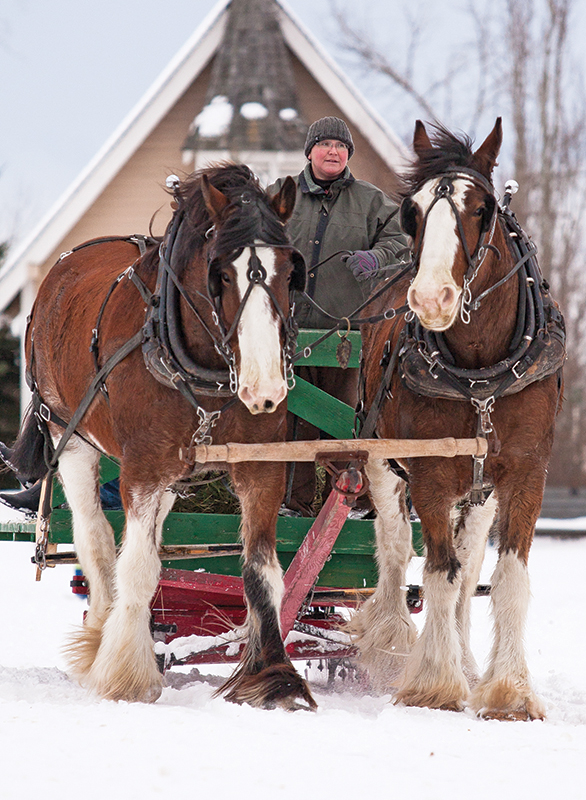
Tim Awckland of River Run Farm Clydesdales was attracted to Clydesdales by their conformation, flowing movement, and docile temperament. He finds them easy to train and drive, and says they quickly become your best friend. Photo: Krystina Lynn Kowalik
Harness horses need to be well-broke to drive with correctly-fitted harness. When lined up after driving the judge inspects several things closely, including quality of feet and hair, and soundness. The feet should be big and well-shod. Teams should be well-matched and work together.
It’s much the same in halter, but here the emphasis is strictly on the quality of the animal and its way-of-going, which should be straight, true in front, and close behind. The head should be set high on a long neck.
Gregg says, “I like to see a good, big, open hoof with nice slope to the pastern; a good flat, long clean hock; a horse that stands correctly; strong over the top line with good length of rib and also free of blemishes.”
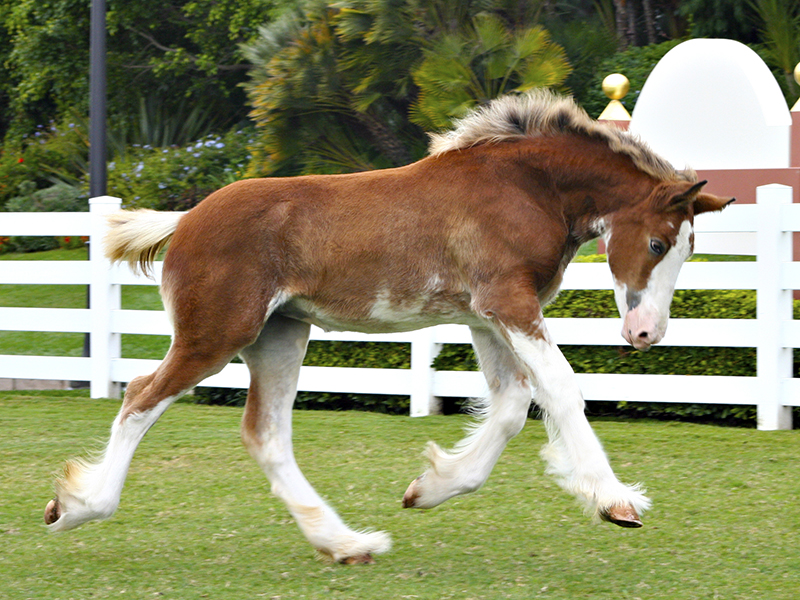
About 350 Clydesdale foals are registered in Canada each year, and interest is strong as people recognize the versatility of this good-natured breed. Photo: iStock/WHammer
A beautiful Clydesdale in the ring is utterly impressive, made all the more so, Awckland says, since they are the most recognized breed because of their use by Budweiser.
There is no doubt that the Budweiser Clydesdales trained for promotions and appearances, and featured in commercials by the Anheuser-Busch Brewing Company, are the most recognized of all draft horses. The organization has between 170 and 180 horses and the majority are stabled at their Warm Springs Ranch in Boonville, Missouri. Horses in the Budweiser hitch must be geldings at least 18 hands and four years of age with a bay coat, four white stockings, a blaze, and weigh between 800 and 1,000 kilograms.
“I have 28 broodmares in the breeding herd and two stallions on site,” says John Soto, Warm Springs Ranch Supervisor. “We use our own stallions, and the stallions or product of the stallions of other breeders. We are always looking for new bloodlines so we will use shipped semen from a particular stallion in the US or Canada. If we go to a show and we see a few particularly nice colts from a stallion we will look him up, see who he is related to, who he is if it is a stallion we don’t know, then maybe get some semen from him next year, or even that same year.”

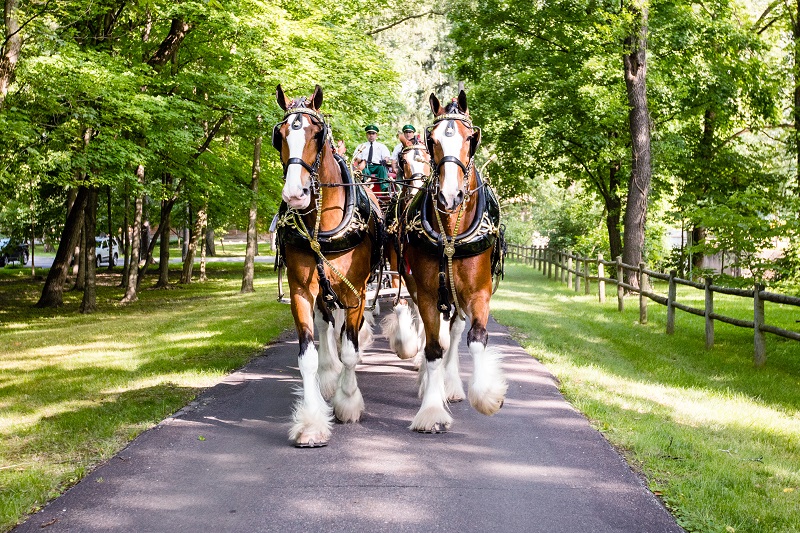
The magnificent Budweiser Clydesdales eight-horse hitch. All horses in the hitch must be at least four years old and 18 hands, bay with four white stockings and a glaze, and weigh between 800 and 1000 kilograms. Photos: Anheuser-Busch
This spring, Szumutku sold their colt Clydesdale Creek’s Conway to the brewing company and he is currently in training.
Soto has been with the Anheuser-Busch Brewing Company almost 38 years and started travelling with the Budweiser Clydesdales when he was 21. Travelling hitches are based in St. Louis, Missouri (the company’s headquarters), Fort Collins, Colorado, and Merrimack, New Hampshire.
“They spend about a year in New Hampshire and [the horses] learn to drive single or with another horse,” says Soto. “By the end of the year, they will have learned to be driven in an eight-horse hitch. For the first time [in their training], the newbie would be positioned either behind the leaders or with other older horses perhaps in the middle of the pack. By the time they leave New Hampshire they know everything about being driven. The driver will decide where the young horses will get their experience on the road. They are very good learners.”
Soto says that each team travels with a seven-person crew. Four people care for the horses, two people care for the harness, one has a day off and all seven must know each other’s responsibilities including truck driving and setting up the stalls. Everything has to be done exactly right and new people to the team are shown precisely what to do and how. There are no short cuts.
“There’s an art to it but everyone knows how to make it look right,” he says. “Even if you have been driving a pair of horses, each time you add another pair it is a whole new ball game. You may be good at handling six horses but that extra pair making it eight horses changes everything. What they are doing is driving four teams individually. You have the weight of all the lines, especially if two horses are particularly fired up over something. That is why we have two drivers. They will switch off back and forth if their arms are getting tired or their fingers are getting numb. They do the driver training in Merrimack, New Hampshire. If we have a young guy who shows some potential he can go behind the scenes and drive the horses to develop his skills instead of fine-tuning them in front of the public. He will advance so much more. But then there is that need to actually do a real parade and, if you’ve got a young guy up, you let him go down a straight street. You’re building his experience.”
Along with the drivers is the Budweiser Clydesdales’ beloved mascot – a dalmatian dog. Historically, the dalmatian was a coach dog used to run in front of carriages to help guide the horses and as a guard dog while the driver was making deliveries. Today, the Budweiser dalmatian sits proudly with the drivers on the iconic red, white, and gold beer wagons.
“Since 1950 the dalmatian has been the mascot of the Budweiser Clydesdale,” says Soto. “We don’t raise our own. We use different breeders. If the puppy is an amazing dog and we need another we go right back to that same breeder. They are so much a part of the Clydesdales.”
The Budweiser tradition began in April, 1933, when August A. Busch, Jr., and Adolphus Busch III surprised their father August A. Busch, Sr., with the gift of a six-horse Clydesdale hitch to commemorate the repeal of Prohibition, the Act that banned the sale of alcohol. As the hitch carried the first post-Prohibition case of beer from the brewery down the streets of St. Louis, it became not just a celebration but an instant brand recognition. A second six-horse hitch was sent to New York where the crowd went wild at the Empire State Building as a case of Budweiser beer was presented to former Governor Alfred E. Smith in thanks for the years he gave fighting Prohibition. Shortly after, the six-horse teams were increased to eight-horse hitches.
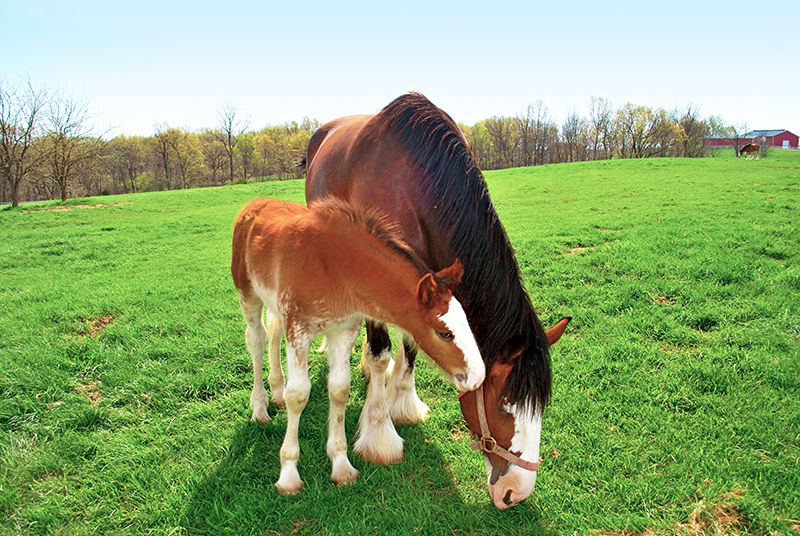
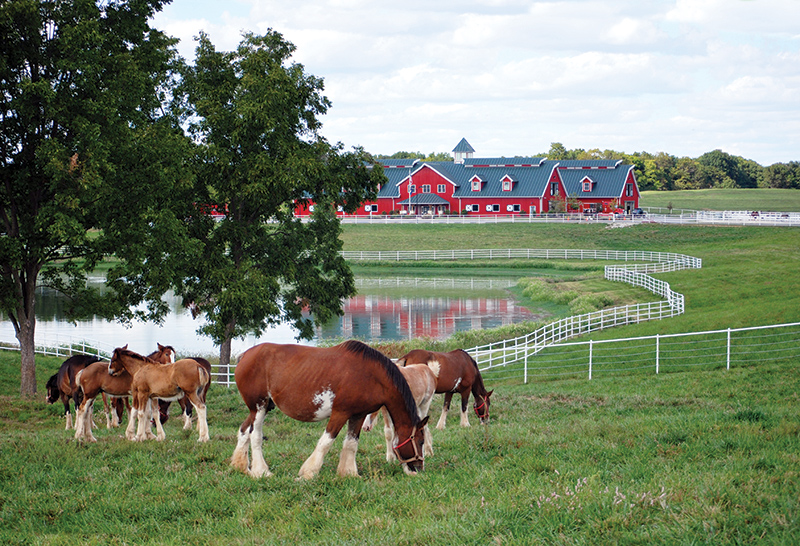
The Anheuser-Busch Brewing Company keeps between 170 and 180 horses including 28 broodmares and two stallions, most of whom live at Warm Springs Ranch in Boonville, Missouri. Photos: Anheuser-Busch
Whether in a hitch pulling a wagon or on a farm pulling a plow, their adaptability and learning skills underscore the great versatility that is the hallmark of Clydesdales.
“Their versatility is probably one of the greatest traits of the breed,” says Dave Hayward who owns Covered Bridge Clydesdales in Rusagonis, New Brunswick. “We have had the very good fortune of having some exceptional examples of this over the years with horses that could not only compete at a very high level but also be able to work in the barn, in the field or woods, in harness, or under saddle [and] in the show ring with children and adults alike. That is of tremendous value in any breed. In most cases, the personality of the Clydesdale horse is second to none while not sacrificing the athleticism and presence of a show horse.”
Hayward began his breeding program with his father some 35 years ago and it grew to include his brothers who are all breeding, raising, and showing Clydesdale horses. Farm work and showing, says Hayward, are not mutually exclusive as the discipline of work makes a huge difference at the shows.
As much as Clydesdales are such an iconic and versatile breed, like other breeds they can have some challenges. When Awckland started their breeding program in the early 2000s they found some great breeding stock to get going and considered themselves fortunate. But even so, he says, there is a fertility issue with some stallions. “Clydes tend not to be as prolific as some of the other breeds.”
Lewis agrees. Both she and her husband came from families involved in draft horses.
“When Steve and I married, we carried on both facets of the draft horse industry – breeding and driving,” she says. “The breeding aspect was a huge challenge as the Clyde seemed to have a very small gene pool to pick from, resulting in weak foals being born. We went outside Ontario and bought some stallions to outcross our better mares. We now don’t have nearly the problem. There is nothing more heartbreaking than losing foals!”
That lack of vigour at birth is something Hayward, too, has seen.
“They are known to lack a certain vigour when born; that is without a doubt the biggest challenge with breeding Clydesdales,” he says, while adding that there are few things more gratifying when the selection of stallion and mare do work out.
Szumutku lost his father in 1988 and their Clydesdale breeding program was on hold while he focused on farm work, running a business, and raising a few cattle. He married Louise in 1992, and she who encouraged him to get back in the game. He paid close attention to pedigrees, knowing that the lack of genetic diversity in the breeding pool could compromise the offspring, and he was prepared to borrow the money to buy the right one if necessary.
“We faced a lot of challenges getting back into the breeding stock we needed,” he says. “The market was quite expensive and there just weren’t many good mares for sale. I did a lot of studying of successful breeders and winning pedigrees. We started with one mare we had raised and one mare we had bought. We then leased a stallion we thought would cross well. We tried to raise modern horses along with timeless qualities. To me, quality [conformation], colour, size and disposition were very important. We have always stuck to that.”


The Budweiser tradition began in 1933 in St. Louis, Missouri, to celebrate the repeal of Prohibition. The traditional dalmation coach dog and Budweiser Clydesdales’ mascot sits with the drivers on the beer wagons. Photos: Anheuser-Busch
The “right one” starts not only with conformation but solid, healthy, proportionate feet. In the selection for certain qualities, Szumutku says that some breeders were turning out Clydesdales with small feet. Now that has turned around and show ring judges are looking at the feet as an overall aspect of the horse’s desired conformation.
“In general, the qualities of the feet are good,” says Gregg. “Clydesdales have, in my opinion, been bred for a big foot. They are a big horse. Hoof care is important and sometimes not done as often as needed on some horses. Big open feet, well taken care of, will help keep an animal sound longer than a smaller-footed horse in my experience.”
Attention to conformation is something of great importance to Szumutku. “I was talking to people about putting on a clinic. I wanted to do a half-day clinic on conformation and what makes a horse sound. But there was no interest. That really bothered me because it told me that people weren’t interested in the basics of how a horse moves and works, what it can accomplish with the right conformation, and what it may suffer without it.”
To illustrate the point, he says that a Clydesdale can cover the most distance of any breed at a walk because of its long stride. That made the horse valuable for ploughing and cutting hay and other farm work involving long days of pulling farm equipment.
“There is a belief that most draft horses can either be good halter horses or good harness horses, but not both,” he says. “We raised a horse by the name of Clydesdale Creek’s Jacob. Jacob was known for his winning ways in halter and he also had a great disposition. People wondered if he had the heart to be a great harness horse. I remember when the gentleman who bought him hooked him up for the first time. He was concerned that he would not keep up. He told me he was going to hook him up with his best horse just to test him. I told him Jacob would surprise him. He called back after he was done and told me it was like hooking a Corvette up with a Rambler. Needless to say, Jacob became his favourite lead horse!”
Szumutku’s attention to bloodlines and genetics has resulted in many awards along the way. The family’s Clydesdale Creek pedigree has become well-known throughout the draft horse world.

Photo: Michelle Martin Randolph
“The greatest success to me is to have horses that show the characteristics we have always bred for. That to me is the measure of success of any breeder. Buying a winner is one thing; raising them is truly gratifying.”
According to Rare Breeds Canada, the Clydesdale is listed as “at risk,” but breeders have varying opinions on how accurate this is. The Clydesdale Horse Association of Canada recorded 348 purebred registrations for the 2017 year with a membership of 412 annual and life members. But many factors may influence the national population. However, in Australia where they are often referred to as the breed that built the nation, Clydesdales are off the endangered list as their numbers have grown to over 3,000.
“Breeding Clydesdale horses is getting more expensive,” says Szumutku. “Large breeders have cut back and the number of registered foals is down. We must protect and keep breeding programs alive [and] continue to educate and support our young people. Help them get involved in the breeding, showing, and enjoyment of the breed.”
However, he does believe that interest in the breed has remained stable, but what concerns him is that breeders are aging. Young people will need to take over but it’s expensive and a tough business to get into as good breeding stock is limited and hard to get.
“I am not sure what the numbers are but I know breeding is down as a result of western Canada not having as many PMU [pregnant mare urine] farms,” says Lewis. “Many out there had Clydesdales and when that industry finished they sold stock and are not breeding as many now. Also, registrations are down with our national organization due to fewer numbers and costs. A lot of people won’t register their stud colts if they are sure they are going to be geldings. This is too bad because we like to know where our good geldings come from and it would be great recognition for the breeder. Now there are many registered gelding line classes for that reason - to be able to trace the breeding.”
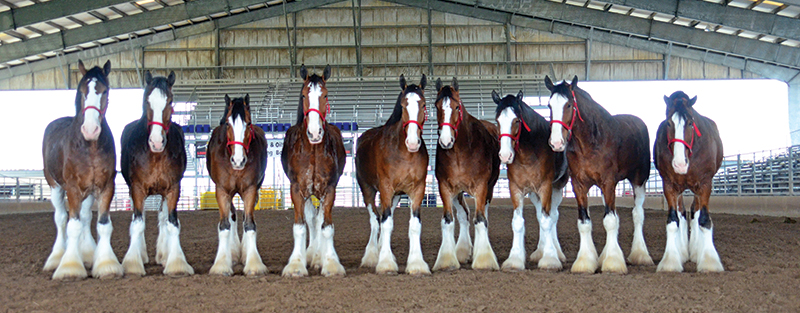
Photo: Michelle Martin Randolph
Gregg appreciates that the genetics issue is of concern in any type of purebred stock and, while there is some concern among Clydesdale breeders, he does not see a reason to panic.
“We are fortunate to have many top breeders in other countries that help keep avenues open for different blood lines,” he says. “Importing and exporting Clydesdales is reasonably easy and pursued enough by some breeders that it certainly helps a lot in the selection of different pedigrees.”
Calvin Martin knows of the “at risk” status, but questions where it comes from or who decides this.
“There are approximately 350 foals registered each year in Canada,” he says. “With not all foals being registered, this means there are likely at least another 100 or more born each year. The registration numbers are very similar in the US. There is also a very sizeable number born and registered in the UK and a smaller number in Australia. I am not sure what kind of number makes a species ‘at risk’ but I do not think the Clydesdale breed is at risk. The interest and demand are steady. It goes up and down and can be affected by the economy, exchange rates, and the World Shows. Some breeders retire or leave the business, but there are always new ones starting up.”
Hayward, too, sees the Clydesdale as stable.
“The Clydesdale breed in North America was the only breed of the major draft horse breeds to not show a decline in a study published in the Draft Horse Journal,” he says. “It should be added that during this study the Clydesdale was actually showing a modest increase. Although this was a very positive takeaway, it was only a snapshot in time. I would love to see more growth and interest in the breed. If we do not involve and engage the youth in all aspects – breeding, working, riding, showing, companionship – we will lose the coming generations and they will not have the opportunity to fully enjoy and appreciate all that they offer.”

Photo: Angelique Cruickshank
Gregg believes the popularity of Clydesdales is currently great. Shows, he says, are well attended and sales are setting records.
“People are realizing the versatility of this breed,” he says, “In general, they are a very good-natured breed of horse to get along with.”
At the Budweiser barn, Soto believes Clydesdales will always be around. If people decide to have a draft horse they may pick a Clydesdale because of the Budweiser influence.
“They are hooked and may have three or four,” he says. “Then they are showing with kids and grandkids. It [becomes] a family thing, a tradition. I don’t see it ever going backwards. People call them ‘gentle giants’ for a reason. The nice thing is, every Clydesdale we have here and that I have worked with is different from every other Clydesdale. They might generally have the same thing but, still, some are a little more inquisitive, some are more friendly and they would sit in your lap if they could, some are a little more standoffish or more shy. Every one of them has a distinct personality and that’s what makes them fun to work with.”
And as much as horses fill people’s lives, so do the lifelong friends who come with them.
“Our biggest success along the way has been the friends we have made,” says Szumutku. “We are fortunate to have met wonderful people throughout the world, because of our horses. Trophies tarnish and ribbons fade, but friends and memories are forever. My dad started me on this journey and my wife encouraged and helped me along the way. We are living the dream I am forever thankful for.”
Related: In Praise of the Percheron
Main photo: iStock/Gannet77




